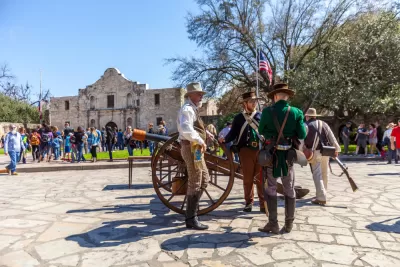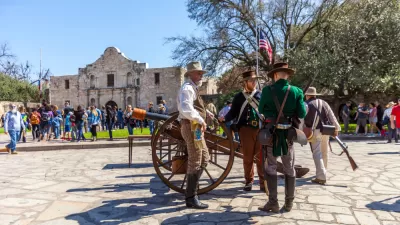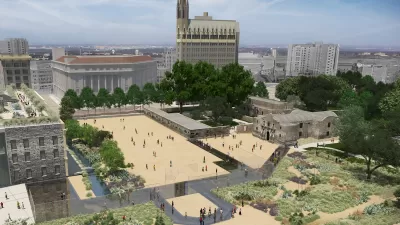Remember that $450 million plan to renovate The Alamo in time for the 300th anniversary of the battle? It's in trouble.

A decision by the Texas Historical Commission will block a key piece of the $450 million master plan to renovate The Alamo Plaza site in San Antonio.
"The Texas Historical Commission's vote to deny a request by city and state leaders to move the Alamo Cenotaph has thrown a $450 million plan to redevelop the site and its surrounding area into uncertainty," reports W. Scott Bailey.
"The plan was to move the Cenotaph south of the Alamo toward Commerce Street as part of a broader redesign of the area to include developing a new Alamo museum and visitors’ center," adds Bailey.
The Cenotaph was erected in 1936 to honor those who died during the Battle of the Alamo in 1836.
The article includes numerous soundbites from officials and elected officials representing the sity, the state, and The Alamo. The Associated Press also picked up the news of the Texas Historical Commission's vote.
For more background on the $450 million master plan for the revitalization of The Alamo, see previous earlier articles shared on Planetizen.
- A First Look at the Alamo's $450 Million Master Plan (April 2017)
- Alamo Plaza Revitalization Takes Small, Controversial Step Forward (September 2018)
- Final Renovation Plan for the Alamo Plaza Approved (October 2018)
FULL STORY: Vote on Alamo Cenotaph puts $450M redevelopment plan in limbo

Alabama: Trump Terminates Settlements for Black Communities Harmed By Raw Sewage
Trump deemed the landmark civil rights agreement “illegal DEI and environmental justice policy.”

Planetizen Federal Action Tracker
A weekly monitor of how Trump’s orders and actions are impacting planners and planning in America.

The 120 Year Old Tiny Home Villages That Sheltered San Francisco’s Earthquake Refugees
More than a century ago, San Francisco mobilized to house thousands of residents displaced by the 1906 earthquake. Could their strategy offer a model for the present?

LA’s Tree Emergency Goes Beyond Vandalism
After a vandal destroyed dozens of downtown LA trees, Mayor Karen Bass vowed to replace them. Days later, she slashed the city’s tree budget.

Sacramento Leads Nation With Bus-Mounted Bike Lane Enforcement Cameras
The city is the first to use its bus-mounted traffic enforcement system to cite drivers who park or drive in bike lanes.

Seattle Voters Approve Social Housing Referendum
Voters approved a corporate tax to fund the city’s housing authority despite an opposition campaign funded by Amazon and Microsoft.
Urban Design for Planners 1: Software Tools
This six-course series explores essential urban design concepts using open source software and equips planners with the tools they need to participate fully in the urban design process.
Planning for Universal Design
Learn the tools for implementing Universal Design in planning regulations.
Ada County Highway District
Clanton & Associates, Inc.
Jessamine County Fiscal Court
Institute for Housing and Urban Development Studies (IHS)
City of Grandview
Harvard GSD Executive Education
Toledo-Lucas County Plan Commissions
Salt Lake City
NYU Wagner Graduate School of Public Service




























